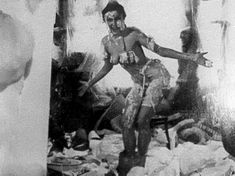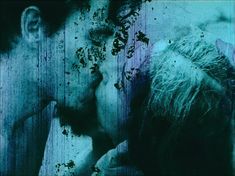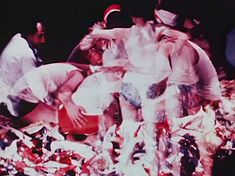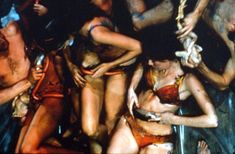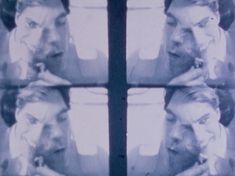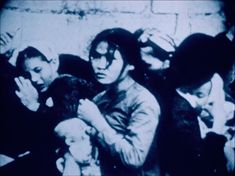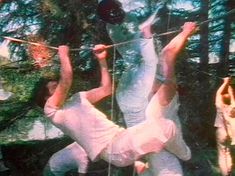Carolee Schneemann
Carolee Schneemann was born Carol Lee Schneiman in 1938 and grew up in Fox Chase, Pennsylvania, USA. Her parents, her father was a country doctor, encouraged her natural approach to physicality and the natural world at an early age. As a teenager, Schneemann frequently visited the Philadelphia Museum of Art. In the late 1950s, she first turned to painting, which was to remain her artistic motor throughout her life, for which she drastically expanded her means. She became the first woman in her family to pursue higher education. In 1955, she received a full scholarship to New York's Bard College, from which she graduated with a Bachlor of Arts (B. A.) degree and changed her last name - as a sign of adopting a new identity - to Schneemann. Another scholarship enabled her to continue her studies at Columbia University. In 1962, she graduated from the University of Illinois with an M.F.A. degree. That same year Schneemann moved to New York City with music theorist and composer James Tenney, where she met George Brecht, Malcolm Goldstein, Philip Glass, Terry Riley, and Steve Reich, among others. Through her mutual friendship with Stan Brakhage, she found her way into experimental film and into the Happening movement, where she met renowned artists including Claes Oldenburg, Merce Cunningham, John Cage and Robert Rauschenberg, and became a founding member of Yvonne Rainer's Judson Dance Theater. She organized the legendary event "A Journey through a Disrupted Landscape," inviting participants to "crawl, climb, go over rocks, scramble, run, walk through mud," advancing social discourse on the body, sexuality, and gender roles.She began to paint her own body, explored the physical interaction with objects, materials and substances in a radical way, and is today considered one of the most important representatives of body and performance art.
Artistic success was initially a long time coming, partly because Schneeman worked primarily in a performative manner and was rather represented at festivals. Photographs, video documentations, sketches and artist notes document her work. In the 1990s, the Fluxus movement underwent a reevaluation. Schneeman was recognized as a central figure in the feminist movement and honored in several group exhibitions. In 1996, New York's New Museum of Contemporary Art devoted her first retrospective, "Up To and Including Her Limits," to the artist. In 2001, the Cornerhouse in Manchester presented a solo exhibition, "More Wrong Things." In November 2015, the Museum der Moderne Salzburg presented a comprehensive retrospective of the artist's work, "Carolee Schneemann. Kinetic Painting," which was taken over by the Museum of Modern Art in Frankfurt and subsequently shown at MoMA PS1 in New York.
In 1993, Schneemann received a grant from the John Simon Guggenheim Memorial Foundation, in 2003 an Eyebeam Residency, and in 2011 she was a United States Artists Rockefeller Fellow for Visual Arts. In 2011, she received The Women's Caucus for Art Lifetime Achievement Award. In 2017, she was awarded the Venice Biennale's Golden Lion for Lifetime Achievement. Schneemann described herself as a painter throughout her life and understood her artistic development as an extension of visual principles beyond the canvas. She passed away in 2019 in New York, USA
Schneemann is considered a U.S. pioneer of first-generation feminist art and became internationally known for her uncompromising avant-garde performances. She began producing films during the first half of the 1960s in which she engaged in nude physical interactions with various materials, such as grease, chalk, fur, mirrors, string, and plastic, and provocatively had snakes crawl on her body. In this way she lived up to the credo of her time, which was to dissolve the boundaries between art and life and become part of art itself. Her early film work "Eye Body", 1963, was called lewd and pornographic by New York art critics. In turn, Schneeman criticized what she saw as the prevalent confusion of "sensuality with pornography." She denounced the patriarchal morality of her time and pleaded for allowing a pleasure in physicality that was not explicitly focused on sex.
The Generali Foundation collection contains legendary film works, including the film "Meat Joy," 1964, staged as an improvised group happening reminiscent of Dionysian rituals and amounting to a "celebration of meat as material" (Schneemann), premiered at the Festival of Free Expression, Paris. More or less clothed individuals handle and play with various objects, materials, and substances, including chicken carcasses, dead fish, sausages, paper, blood, ejaculate, and wet paint, celebrating their interplay as an ecstatic-opulent feast. "Fuses" from 1967 shows Schneeman and her then partner James Tenney having sex, recorded with a 16-mm Bolex camera, observed by her cat Kitch and in such a way - "objectively," according to the artist - because uninfluenced by human moral concepts. Schneeman wanted to find out to what extent a woman's depiction of her own sexual acts differed from pornography and classical art. In post-production, she edited the footage at various speeds, colored and burned images, and painted and drew directly onto the celluloid. Other films in the Generali Foundation Collection, including "Viet-Flakes," 1965, "Water Light/Water Needle (Lake Mah Wah, NJ)," 1966, "Snows," 1976, "Body Collage," 1967, "Illinois Central Transposed," 1968-69, "Plumb Line," 1968-71, "Kitch's Last Meal (Composite)," 1973-78, and "Souvenir of Lebanon," 1983/2006, show the artistic evolution from the beginning to 2006.
Another outstanding work in the collection is "Fur Wheel," 1962 from Schneemann's group of kinetic works. For this wall object, a lampshade was covered with fur from which dented tin cans hang. The rotation of the negative form creates random noises and a kind of optical suction effect. (Doris Leutgeb)
